Content for TR 22.821 Word version: 16.1.0
5.10 Use case for Removal of UE from a private group communication
5.11 Use case for UE part of multiple private communications
5.12 Use Case for enabling Ethernet-based private communication in 3GPP
5.13 Use Case for Service Continuity in private group communication
5.14 Private data communication service using semi-permanent connections
5.15 Use case for multiple private communications in the same network
5.16 Use case on service management
5.17 Factory Automation
5.18 Use case on Industry Communication with stable latency needs
5.19 Use case for accessing 5GLAN via Relay UE
...
...
5.10 Use case for Removal of UE from a private group communication p. 21
5.10.1 Description p. 21
This use case describes the removal of equipment from an existing private group communications.
5.10.2 Preconditions p. 21
A private group communications is already enabled for the communication between equipment A, B and C.
5.10.3 Service flows p. 21
Bob requests to the MNO to remove laptop B from the existing private group communications
The MNO's management function removes B from the member group of this private group communications.
5.10.4 Post-conditions p. 21
Laptop B cannot interact with A and/or C via the private group communications any more.
5.10.5 Potential Impacts or Interactions with Existing Services/Features p. 21
None identified.
5.10.6 Potential Requirements p. 22
[PR 5.10.6-1]
The 5G network shall enable the MNO to remove a UE from a specific group of UEs of a private group communications.
[PR 5.10.6-2]
The 5G network shall ensure that the removed UE has no interference with the private group communications that the UE has been removed from.
[PR 5.10.6-3]
The 5G network shall ensure that removal of UE from a particular private group communication has no impact on other private group communications including the same UE.
5.11 Use case for UE part of multiple private communications p. 22
5.11.1 Description p. 22
In the enterprise, some equipment may be common for usage by different departments, e.g., a server and a printer can be common to multiple departments.
Bob needs multiple independent communications between UEs of different departments but also want some common equipment to be used by equipments of different departments.
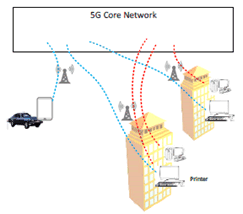
Figure 5.11-1: Use of a common single printer from 2 departments of the enterprise
(⇒ copy of original 3GPP image)
(⇒ copy of original 3GPP image)
5.11.2 Preconditions p. 22
Several UEs (mobile smartphones, computers or mobile laptops, printers…) are available in multiple departments of a company for companies' employees.
5.11.3 Service flows p. 22
The MNO provides 3GPP private communication for some of the company's equipment (e.g., A, B, C) of one department, and provides another 3GPP private communication for some of the company's other equipment (e.g., D, E, F) for another department.
Bob want a specific printer (e.g., P) to be used by equipment of both departments.
Bob gives the unique identification of this equipment P (e.g., IMSI) to the MNO.
The 3GPP MNO updates 3GPP LAN service to enable communication between A, B, C and P, and between D, E, F and P.
5.11.4 Post-conditions p. 22
The 3GPP private communication services between A, B, C and P are enabled. Company equipment A, B and C could use the local printer P.
Then 3GPP private communication services between D, E, F and P are also enabled, Company equipment D, E and F could use the local printer P simultaneously.
Equipment out of these two 3GPP LAN groups cannot use the local printer P.
The communication between A, B, C and P cannot interfere with the communication between D, E, F and P, and vice versa.
5.11.5 Potential Impacts or Interactions with Existing Services/Features p. 23
None identified.
5.11.6 Potential Requirements p. 23
[PR 5.11.6-1]
The 5G system shall enable the MNO to assign a UE to multiple independent 3GPP private communications group.
5.12 Use Case for enabling Ethernet-based private communication in 3GPP p. 23
5.12.1 Description p. 23
The sensors and actuators are using Non-IP transport services (e.g., Ethernet) to transport control signalling in legacy LANs of industry factories.
This use case is about the 3GPP system to consider Ethernet-based protocol for private communications between UEs.
5.12.2 Preconditions p. 23
The sensors and actuators of packaging and printing system are deployed in an industrial factory, and are defined by the MNO as being the valid member of a group for 3GPP private communication.
The sensors detect a product coming from the assembly line and send control signalling to the actuators using non-IP transport services (e.g., Ethernet) via 3GPP network.
5.12.3 Service flows p. 23
The non-IP packets of control signalling are directly forwarded from the sensors to the actuators via the MNO's network.
The required QoS for the non-IP packet are applied by the MNO's network.
5.12.4 Post-conditions p. 23
The actuators of packaging and printing system perform actions for the product correctly and in time.
5.12.5 Potential Impacts or Interactions with Existing Services/Features p. 23
None identified.
5.12.6 Potential Requirements p. 23
[PR 5.12.6-1]
The 5G network shall support the routing of non-IP packet (e.g., Ethernet frame) efficiently for private communication between UEs.
[PR 5.12.6-2]
The 5G network shall be able to provide the required QoS (e.g., reliability, latency, and bandwidth) for non-IP packet (e.g. Ethernet frame) for private communication between UEs.
5.13 Use Case for Service Continuity in private group communication p. 24
5.13.1 Description p. 24
This use case describes continuity of 3GPP private group communication during UE's mobility.
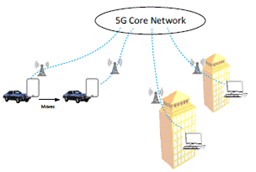
Figure 5.13-1: Service continuity within the 3GPP private group when the UE moves
(⇒ copy of original 3GPP image)
(⇒ copy of original 3GPP image)
5.13.2 Preconditions p. 24
UEs (A, B and C) are defined by the MNO for being part a same private group.
UE C is on a moving car and having video conference call with A and B in the office via 3GPP network.
5.13.3 Service flows p. 24
The MNO keeps the 3GPP communication traffic uninterrupted while UE C is moving in the PLMN.
5.13.4 Post-conditions p. 24
The video conference call between A, B and C is uninterrupted.
5.13.5 Potential Impacts or Interactions with Existing Services/Features p. 24
None identified.
5.13.6 Potential Requirements p. 24
[PR 5.13.6-1] The 5G network support 3GPP service continuity for 5G LAN-type service, i.e., the private communication between UEs shall not be interrupted when one or more UEs of the private communication move within the same PLMN that provides the 5G LAN-type service.
5.14 Private data communication service using semi-permanent connections p. 24
5.14.1 Description p. 24
Farmer X has a large area of land where he grows potatoes. As an innovative farmer, Farmer X has deployed various sensors to continuously measure the condition of his crop. For example, sensors measure the moisture level of the soil and provide this information to an irrigation system. Automatically, movable sprinklers are deployed to provide water in the right areas. Also this sprinkler system uses various sensors (e.g. water pressure) and actuators (e.g. valves). All these sensors and actuators are connected via a 3GPP private data communication service.
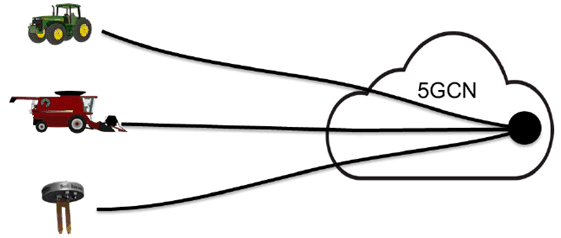
Figure 5.14-1: Private data communication with semi-permanent data connections to a private data network
(⇒ copy of original 3GPP image)
(⇒ copy of original 3GPP image)
5.14.2 Pre-conditions p. 25
Farmer X has subscribed to a private data communication service from MNO-X. His subscription includes a number of private groups.
Farmer X has all its sensors and actuators subscribed to use the 3GPP private data communications service provided by MNO-X.
Farmer X uses different private groups for the different sensors and actuators (e.g. he also has a 3GPP private network group connecting his tractor and various other farm equipment). For security reasons, not all sensors and actuators are allowed to communicate with each other.
Farmer X has configured all the sensors and actuators on which private group(s) they should use.
Through MNO-X, Farmer X has configured the 3GPP private data communications service with the different groups of sensors and actuators that are allowed to communicate with each other.
Through MNO-X, Farmer X has pre-configured what type of data communication is to be used on each private group (e.g. IP, Ethernet, or other). All UEs on the same private group need to use the same type of data communication.
5.14.3 Service Flows p. 25
UE1, UE2, and UE3 each establish a UE-to-network data connection to a Data Network representing the private group.
The 3GPP System checks whether these UEs belong to the private group and authorised to set up a communication with the group.
When the connection is established an address assignment procedure takes place to issue addresses for each of the UEs in the private group.
5.14.4 Post-conditions p. 25
After the data connections are established, these data connections are maintained semi permanently. The UE1, UE2, and UE3 can use point-to-point addresses when they want to send a data packet to a particular other UE. They can also use multicast/broadcast addresses to send a packet to all other UEs in the group.
Note that UE4 which also belongs to Farmer X, but which is in a different group, is not able to send data to UE1, UE2, and UE3. If UE4 knows an address of UE1, UE2, or UE3, sending a packet to that address via the data connection for its own private group will not work.
5.14.5 Potential Impacts or Interactions with Existing Services/Features p. 25
The functionality in this use case could be provided with existing functionality of selecting a corporate APN, or by selecting a specific private DN in 5G. However:
- Current procedures do not support checking whether the UE is part of the private group (and e.g. do not support disconnecting the UE when it is removed from the private group).
- The existing mechanisms behind APNs do not really scale to the extent of multiple private groups per SME, or even consumers. Unsure if the 5G DN concept scales sufficiently.
- The MNO needs standardised support for managing a large amount of private Data Networks. The intention is not to leave the management of such a Data Network to SMEs or consumers.
5.14.6 Potential Requirements p. 26
[PR 5.14.6-1]
The 3GPP System shall support the establishment and control of communication from a UE to its private group.
[PR 5.14.6-2]
Only UEs that are part of the private network group shall be able to establish or maintain communication to a private group.
[PR 5.14.6-3]
The 3GPP network shall enable the network operator to ensure confidentiality and isolation of communications for the private group.
[PR 5.14.6-4]
The 3GPP 5G network shall enable the network operator to ensure UEs that belong to a different private group cannot send data to any or all of the UEs in the group.
[PR 5.14.6-5]
The 3GPP network shall enable the network operator to support point-to-point addressing as well as multicast addressing between the different UEs in a private group. It is assumed that all UEs in a same private group use the same type of addresses (e.g. IP, Ethernet or other).
[PR 5.14.6-6]
The 3GPP network shall enable the network operator to create, manage, and remove private groups including their related functionality (subscription data, routing and addressing functionality).
5.15 Use case for multiple private communications in the same network p. 26
5.15.1 Description p. 26
In the enterprise, there are several departments, and the head, Bob, needs multiple independent groups of UEs communicating together for each department .
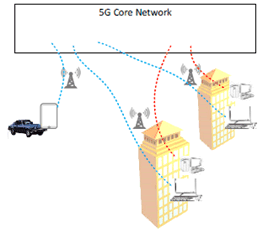
Figure 5.15-1: Two independent groups of UEs communications for the same enterprise
(⇒ copy of original 3GPP image)
(⇒ copy of original 3GPP image)
5.15.2 Preconditions p. 27
Several UEs (mobile smartphones, computers or mobile laptops, printers…) are available in multiple departments of a company for companies' employees.
5.15.3 Service flows p. 27
Bob requests to the 3GPP MNO to provide 3GPP private communications for some of the company's equipment (e.g., A, B, C) of one department, and to provide another 3GPP private communications for some of the company's other equipment (e.g., D, E, F) of another department. Bob gives the unique identifiers of these equipments to the MNO.
The 3GPP MNO provides 3GPP private communications for A, B, C and provides another for D, E, F.
5.15.4 Post-conditions p. 27
The 3GPP private communication service between A, B and C is enabled, and also the 3GPP private communication service between D, E and F is enabled. Equipment A, B and C (and also D, E and F) can communicate amongst each other (e.g., file sharing, neighbour discovery).
Equipment outside these two UE groups cannot interfere with the communication between A, B and C and the communication between D, E and F.
The communication between A, B and C cannot interfere with the communication between D, E and F, and vice versa.
5.15.5 Potential Impacts or Interactions with Existing Services/Features p. 27
None identified.
5.15.6 Potential Requirements p. 27
[PR 5.15.6-1]
The 5G network shall enable the MNO to provide independent private communications between UEs for different groups of UEs.
[PR 5.15.6-2]
The 5G network shall support independent private communications between UEs for different groups of UEs.
5.16 Use case on service management p. 27
5.16.0 Overall Description p. 27
3GPP MNO enables private communications, i.e., enable a restricted set of UEs to communicate amongst each other via 3GPP network in order to support enterprise, residential homes and industry equipment communications.
5.16.1 Description p. 27
Bob is the head of a company who has to face enterprise network building and maintenance expenditure. Bob needs private communications between its employees' office equipments (computers, printers…) and with employees' mobile equipments (laptops, smartphones…).
Bob does not want to configure a LAN and prefers to offload the private communication management with work of configuration, maintenance and control that communication is only allowed amongst the UEs of his enterprise, to 3GPP MNO.
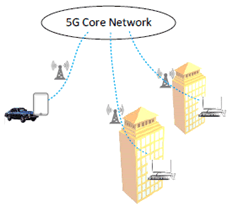
5.16.2 Preconditions p. 28
Several UEs (mobile smartphones, computers or mobile laptops, printers…) are available to a company. These UEs may be in any of multiple office buildings of that company or may be brought outside the office buildings by company employees.
5.16.3 Service flows p. 28
Bob requests to the MNO to provide private communication service for some of its company's equipments. Bob gives a unique identification of these equipments (A, B, C) (e.g., IMSI) to the 3GPP MNO.
The MNO defines the group members for this enterprise 3GPP LAN as A, B and C.
5.16.4 Post-conditions p. 28
The 3GPP private communications between A, B and C is enabled. Equipment A, B and C can communicate amongst each other (e.g., file sharing, neighbour discovery, LAN game).
UEs out of this private group cannot interfere with the communication between A, B and C.
5.16.5 Potential Impacts or Interactions with Existing Services/Features p. 28
None identified.
5.16.6 Potential Requirements p. 28
[PR 5.16.6-1]
The 5G network shall enable the 3GPP network operator to define set of UEs allowed to communicate together in a secured way.
[PR 5.16.6-2]
The 5G system shall ensure the 3GPP communication between UEs of a defined set of UEs with no impact with communications of other UEs not belonging to this set.
5.17 Factory Automation p. 28
5.17.1 Description p. 28
In this use case a factory producing electronic goods using highly precise automated robots co-ordinated by tight closed-loop control has used 5G replace some of the wired Ethernet connections. There are several drivers to replace wired links with wireless links. For example, devices are mobile, cables need to go through hazardous areas, or moving parts in a machine need connectivity. Further, providing wireless connectivity can enable rapid reconfiguration of a factory, which can yield improvements in productivity. Figure 5.17-1 describes a small section of the factory deployment where 5G is used to connect devices T, C and S.

5.17.2 Preconditions p. 28
A factory producing electronic goods using highly precise automated robots co-ordinated by tight closed-loop control has used 5G to replace some of the wired Ethernet connections.
The factory robots currently support real-time Ethernet according to IEC 61784 [3] along with a suite of features for industrial automation. These features support the fast routing, broadcast, support of virtual LANs, and Ethernet QoS classification.
5.17.3 Service flows p. 28
Ethernet switches/devices T, E, and D can transmit Ethernet frames to Ethernet switches/devices A, B, C, and S. These frames are sent with Ethernet-based routing and transmission information based on real-time Ethernet according to IEC 61784 [3] and the suite of features supported at the Ethernet switches/devices. These Ethernet frames are transported by the 5G network and routed to the correct destination 5G UE before being unpacked and forwarded to the correct Ethernet switch/device
5.17.4 Post-conditions p. 28
The factory robots operate in an accurately controlled manner and perform the exact duties as defined by the factory operator.
5.17.5 Potential Impacts or Interactions with Existing Services/Features p. 28
5.17.5.1 Routing based on Ethernet headers p. 29
Consider the scenario where Device D sends an Ethernet frame with destination address as the Ethernet MAC address of Device A or Device B. In this case, the Ethernet frame must be routed to UE 1. UE 1 should then forward the frame to the Ethernet switch S. Note that the Ethernet frame must not be sent to UE 2. Thus, the 3GPP system must support the routing functionality based on Ethernet frame header information.
5.17.5.2 Broadcast p. 29
Consider the case where Device D sends an Ethernet frame with destination address as the broadcast address. In this case, the frame should be forwarded to both UE 1 and UE 2. Thus, the 3GPP system must support Ethernet broadcast frames.
5.17.5.3 Spanning Tree p. 30
Suppose that in Figure 5.17-1, Device C was also connected to Switch S. Then Device C, Switch S, UE 1 and UE 2 will form a loop. A spanning tree algorithm (e.g., RSTP) allows the switches in an Ethernet network to negotiate a single path to each entity. This is instantiated by the Ethernet network blocking certain ports. In this example, the algorithm may result in blocking transmissions to Device C via one of the UEs (either UE1 or UE2), depending on the result of the algorithm path calculations. This is because the spanning tree algorithm finds the shortest path between a selected root node and the device of interest (in this case Device C), and blocks the other paths to that same device. Once a path is chosen, and other paths are blocked, in order to enforce this outcome, a broadcast frame must not be forwarded through the blocked path. This means that broadcast frames must not be forwarded to the blocked UE. Thus, routing of Ethernet frames in the 5G system must be based on the outcome of spanning tree algorithm run by the Ethernet network being served.
The way the paths are found is via Ethernet switches sending of Bridge Protocol Data Units (BDPUs) with information on available ports. As Ethernet devices other than switches do not send BPDUs, in order to find out the network topology behind the UE it is necessary to limit to a single Ethernet device connected to the UE. If there is a desire to connect multiple Ethernet devices to a UE, then a switch can be connected to the UE and multiple Ethernet devices can be connected to the switch, as it is shown in UE1 in Figure 5.17-1.
5.17.5.4 Virtual LAN p. 30
Consider the case where UE 1 belongs to VLAN V1 and UE 2 belongs to VLAN V2. If a broadcast frame is received by the PDN marked for VLAN V1, it must be forwarded to UE 1 but not to UE 2. Thus, the routing of Ethernet frames must be based on the VLAN ID.
5.17.5.5 QoS p. 30
Ethernet traffic flow classification must be based on Ethernet headers - Source and Destination MAC address, Ethertype (including multiple Ethertypes in double-tagging), VLAN tags including VLAN ID and PCP, in addition to the existing fields used in Traffic Flow Templates (TFT). Thus, packet filtering and choice of 5QI should be based on Ethernet header information.
IEEE Time Sensitive Networking (TSN) Task Group is developing the TSN standard, whose goal is to provide deterministic services through IEEE 802 networks. TSN provides many of the services needed in factory automation applications, e.g., time synchronization, and ultra-reliability through redundancy [4, 5, 6]. The Stream Reservation Protocol (SRP) in TSN requires resource reservation at each intermediate device.
As described earlier, Factory Automation applications have stringent requirements on latency, jitter and error rate. Further study may be needed to determine how these requirements can be met in a 3GPP system.
5.17.6 Potential Requirements p. 30
[PR.5.17.6-1]
The 3GPP system shall be able to support an Ethernet transport service.
[PR.5.17.6-2]
The Ethernet transport service shall support routing based on information extracted from Ethernet frame headers by the 3GPP system.
[PR.5.17.6-3]
The Ethernet transport service shall support routing based on information extracted from Virtual LAN (VLAN) ID by the 3GPP system.
[PR.5.17.6-4]
The Ethernet transport service shall support routing based on information extracted by the 3GPP system from the Bridge Protocol Data Units created in the Ethernet network based on a Spanning Tree Protocol (e.g. RSTP).
[PR.5.17.6-5]
The Ethernet transport service shall support the transport of Ethernet frames between UEs that an Ethernet device connected to it.
[PR.5.17.6-6]
The Ethernet transport service shall support the transport of Ethernet broadcast frames.
[PR.5.17.6-7]
The Ethernet transport service shall support traffic filtering and prioritization based on source and destination MAC addresses.
[PR.5.17.6-8]
The Ethernet transport service shall support traffic filtering and prioritization based on Ethertype (including multiple Ethertypes in double-tagging)
[PR.5.17.6-9]
The Ethernet transport service shall support traffic filtering and prioritization based on 802.1Q VLAN tags (including double tagging).
[PR.5.17.6-10]
The 3GPP system shall support sufficient QoS capabilities to be able to meet the request in the Ethernet header information.
5.18 Use case on Industry Communication with stable latency needs p. 31
5.18.1 Description p. 31
Factory manager, Bob, has deployed a traditional factory network for connecting sensors, actuators and controllers.
A motion controller periodically sends desired set points to one or several actuators which thereupon perform a corresponding action on one or several processes. This is done in a strictly cyclic and deterministic manner. In order to avoid a later transmission arrives before an older one, the actual latency for each packet delivery should be stable, i.e., not too early nor too late. In factory network, Industrial Ethernet technologies can be used, such as 802.1Qbv based Ethernet Switch, which guarantee latency for each Ethernet packet delivery is stable inside the Enterprise network.
Now as an innovative farmer, Bob deploys new type of actuators with 5G capability and 5G subscription to measure the condition of the product. These actuators are connected to 3GPP network and communicate with the factory network.
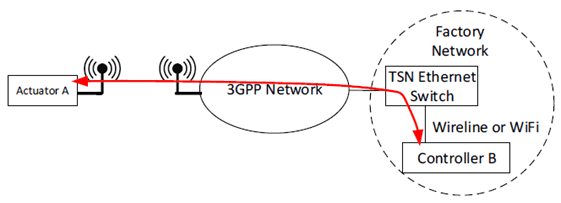
Figure 5.18-1: industry communcation between Actuator A and Controller B in factory network
(⇒ copy of original 3GPP image)
(⇒ copy of original 3GPP image)
5.18.2 Preconditions p. 31
A controller B in Ethernet based factory network is connected to the factory network by using fixed wireline, WiFi, etc.
A new type of actuator A using the 5G LAN-style services provided by MNO X, establishes a UE-to-network data connection and accesses the factory network via the 3GPP network.
5.18.3 Service flows p. 31
Controller B sends data (e.g., desired set points) to Actuator A.
The data is transferred to the 3GPP network through 802.1Qbv based Ethernet Switch.
3GPP network forwards the data containing the Ethernet packet to Actuator A while guaranteeing stable latency of each Ethernet packet.
5.18.4 Post-conditions p. 32
Actuator A receives data from Controller B and performs action in time.
5.18.5 Potential Impacts or Interactions with Existing Services/Features p. 32
None identified.
5.18.6 Potential Requirements p. 32
[PR 5.18.6-1]
The 5G system shall provide a mechanism to ensure the jitter for transporting Ethernet packets is limited by a certain time boundaries.
[PR 5.18.6-2]
The 5G system shall be able to provide an Ethernet transport service.
[PR 5.18.6-3]
The Ethernet transport service shall support routing based on information extracted from the Ethernet header information created based on 802.1Qbv.
[PR 5.18.6-4]
The Ethernet transport service shall support traffic filtering and prioritization based on information extracted from the Ethernet header information created based on 802.1Qbv.
5.19 Use case for accessing 5GLAN via Relay UE p. 32
5.19.1 Description p. 32
Remote UE access to 5G LAN-style service is not considered in 5GLAN TR currently while it should be possible to allow a devices to use 5G LAN-style services and be under MNO control even when such device connects to 3GPP network via a relay UE (the relay UE could be either part of 5GLAN or not).
5.19.2 Preconditions p. 32
Mike has several home devices connected to the 3GPP network offered by the MNO.
Mike has his laptop connected to one of the home devices and want to use the 5G LAN-style service in his office, i.e., communicate with the PCs in the office.
5.19.3 Service flows p. 32
Mike requests the MNO to join with his laptop the private group made of the PCs in the office.
The MNO authorize Mike's laptop and add it to the private group of the office.
5.19.4 Post-conditions p. 32
The laptop could communicate with the PCs in the office via the home device, with the same service level as if the laptop was in the office, i.e., required QoS for the Ethernet packets transferred between the laptop and PCs in the office, service continuity when the laptop changes the connection from one home device to another.
5.19.5 Potential Impacts or Interactions with Existing Services/Features p. 32
None identified.
5.19.6 Potential Requirements p. 32
[PR 5.19.6-1]
The 5G network shall enable the MNO to authenticate and authorize a remote UE in indirect mode under a relay UE to use 5G LAN-type service.
[PR 5.19.6-2]
The 5G network shall allow the MNO to add/move a remote UE in indirect mode to/from a private set for a 5G LAN-type service.
[PR 5.19.6-3]
The 5G network shall be able to provide a remote UE using 5G LAN type service via a relay UE with same level of service as if the remote UE would be in direct mode (i.e. provide required QoS for the Ethernet packets transferred between remote UE and relay UE if they using 3GPP access).
[PR 5.19.6-4]
The 5G network shall be able to support service continuity for the communication between a remote UE with other UEs belonging to the same private communication of 5G LAN-type service, when the remote UE changes from one relay UE to another or when the UE changes between direct and indirect mode.